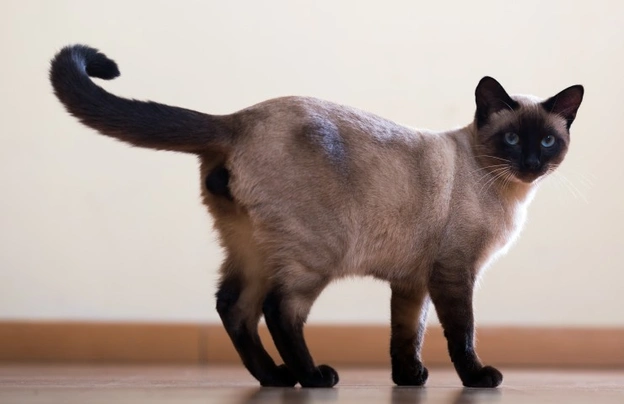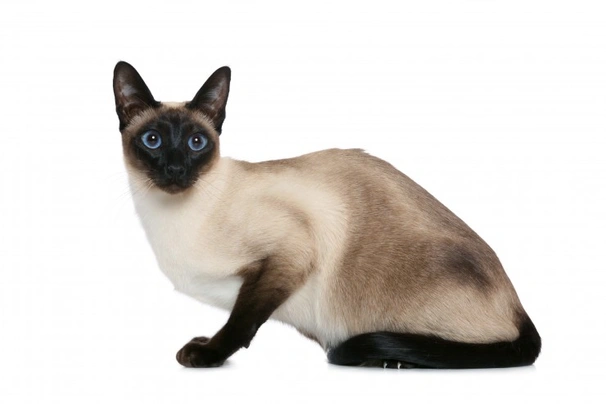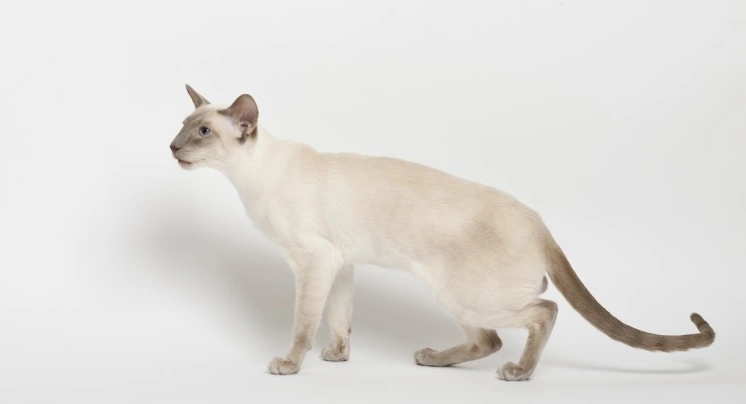Siamese
Introduction of the Siamese
For decades the Siamese has consistently been one of the most popular breeds on the planet and for good reason. These charming blue eyed cats are not only extremely attractive but they boast being wonderful companions and family pets more especially for people who spend a lot of time at home. The Siamese is well known for being one of the most talkative felines around and will happily hold a long conversation with their owners whenever they can. They are athletic lithe medium size cats that thrive on human company and don't particularly like being left on their own for any length of time.
History of the Siamese
The Siamese is one of the oldest breeds in the world and are originally from Thailand which was formerly known as Siam. They were considered sacred cats and were used to guard Buddhist temples. Throughout time kittens were highly sought after and anyone who was given a Siamese Kitten was thought to be honoured by such a sacred gift. In ancient times if a Siamese cat was stolen from the Royal Court the crime was punishable by death.
Although an ancient breed the Siamese did not arrive on British shores until the 1880s with the original cats boasting classic seal brown points on cream bodies. However breeders began developing more colours and they did so by introducing other breeds into the mix. To begin with Siamese cats were born with squints but this eye problem is now considered a serious fault although in times long past the fact that a Siamese cat was "cross-eyed" led to many fables being told about them.
Today the Siamese cat remains one of the most popular breeds not only in the UK but elsewhere in the world too. They not only boast lovely looks with their points and startling blue eyes but they are known to be among the most talkative cats on the planet which adds to their charming albeit rather demanding personalities.
Appearance of the Siamese
The Siamese is one of the most recognisable breeds around with their lovely points and startling blue eyes. They are extremely well-balanced cats that boast having athletic lithe bodies and elegant fine legs. They have wedge-shaped heads and they always have an alert intelligent look about their bright blue eyes. There is a nice width between a cat's ears which narrows perfectly to their fine muzzles. They have straight profiles with strong chins and a nice level bite. Their ears are on the large size and pricked being wider at the base and set so they follow the line of a cat's wedge-shaped head. They have very oriental eyes that slant towards the nose and which have a nice width between them.
They have medium size svelte long bodies and their legs are nicely in proportion being on the slim side. A cat's hind legs are longer than their front ones which adds to their athletic and graceful appearance. Feet are oval shaped and small. They have long tapering tales that should be straight and never kinked. When it comes to their coat the Siamese boasts having a close-lying and extremely glossy coat with points being clearly defined on the following parts of a cat's body:
- Mask
- Ears
- Feet
- Tail
The rest of a Siamese cat's body is lighter with shading on their backs sides whereas bibs chests and bellies are pale. They come in a variety of colours which are as follows:
- Seal Point
- Blue Point
- Chocolate Point
- Cinnamon Point
- Caramel Point
- Fawn Point
- Apricot Point
- Tabby Point
- Seal Tabby Point
- Chocolate Tabby Point
- Lilac Tabby Point
- Red Tabby Point
- Cream Tabby Point
- Cinnamon Tabby Point
- Caramel Tabby Point
- Fawn Tabby Point
- Apricot Tabby Point
- Blue Tortie Tabby Point
- Chocolate Tortie Tabby Point
- Lilac Torties Tabby Point
- Cinnamon Tortie Tabby Point
- Caramel Tortie Tabby Point
- Fawn Tortie Tabby Point
- Red Point
- Seal Tortie Point
- Blue Tortie Point
- Chocolate Tortie Point
- Lilac Tortie Point
- Cinnamon Tortie Point
- Caramel Tortie Point
- Fawn Tortie Point
- Cream Point
Temperament of the Siamese
Like a lot of other breeds the Siamese likes a routine and doesn't particularly like it when this changes for any reason. They like to be fed at the same time of the day and don't appreciate it when any furniture gets moved around the home. They are well known for being extremely vocal by nature and will happily hold a long conversation with their owners to let them know if they are happy or unhappy about a situation. The Siamese tends to be rather demanding and does not like to be left on their own for any length of time. As such they are best suited to households where at least one person stays at home when everyone else is out of the house. They are real extroverts and enjoy the company of another Siamese cat more especially if they have grown up together in the same household.
They are very smart cats that boast a ton of energy which means they need to be kept busy when they are not napping that is. It's important to invest in good quality toys and scratching posts when sharing a home with a Siamese especially if they are kept as indoor pets. It’s also important to have enough time to spend with them because the Siamese thrives on being as much attention as they can get.
Intelligence / Trainability of the Siamese
As previously mentioned the Siamese is an intelligent cat and one that learns new things extremely quickly. They enjoy playing interactive games which includes things like "fetch" and chase the ball. They are also quite adept at learning how to open cupboards and doors when they want to. Because they form such strong bonds with their owners Siamese cats thrive on following them about wherever they go and like to be involved in everything that goes on in their environment.
They adore exploring their environment but a Siamese should only be allowed to roam around in the great outdoors if it is safe for them to do so. They do tend to feel the cold so care has to be taken if they are allowed to go outside during the winter making sure that a cat can always get back inside when they need to get back in the warm.
Children and other
Siamese with their outgoing affectionate personalities are a great choice for families with children. They are quick on their feet and therefore know when to get out of the reach of smaller children when they get too boisterous or loud. However care has to be taken when very young children are around cats and any interaction should always be supervised by an adult to make sure playtime stay nice and calm. With this said children need to be taught how to behave around cats and when it's time to leave them alone.
They also get on well with dogs especially if they have grown up together in the same household. However care has to be taken when introducing a Siamese to dogs they don't already know just in case the dog does not get on with their feline counterparts. Siamese are incredibly social by nature and have been known to get on with pet birds and small animals. However it's always wiser to keep a close eye on any cat when they are around smaller pets particularly when they first meet each other just to be on the safe side.
Health of the Siamese
The average life expectancy of a Siamese is between 15 and 20 years when properly cared for and fed an appropriate good quality diet to suit their ages.
The Siamese is known to suffer from a few hereditary health issues which are worth knowing about if you are planning share your home with one of these talkative high energy cats. The conditions that seem to affect the breed the most include the following:
- Progressive retinal atrophy (PRA) - breeders should have stud cats DNA tested
- Mucopolysaccharidosis - breeders should have stud cats tested
- Gangliosidosis (GM1) - breeders should have stud cats tested
- Niemann-Pick disease
- Hip dysplasia
- Systemic amyloidosis
- Mediastinal lymphoma
- Certain intestinal tumours
- Chronic coughing (asthma)
- Vomiting
- Pica
Caring for the Siamese
As with any other breed Siamese cats need to be groomed on a regular basis to make sure their coats and skin are kept in top condition. On top of this cats need to be fed good quality food that meets all their nutritional needs throughout their lives which is especially true of kittens and older cats.
Grooming of the Siamese
The Siamese boasts having a short close lying very glossy coat and as such they are low maintenance on the grooming front. A weekly brush and wipe over with a chamois leather is all it takes to keep their coats in good condition with a nice sheen on it. They adore being groomed and thrive on the contact they are given when they are being brushed. Like other breeds they tend to shed the most in the Spring and then again in the Autumn when more frequent brushing is usually necessary to keep on top of things.
It's also important to check a cat's ears on a regular basis and to clean them when necessary. If too much wax is allowed to build up it can lead to a painful infection which can be hard to clear up. In short prevention is often easier than cure with ear infections. Cats often suffer from ear mites which can be a real problem which is why it's so important to check their ears on a regular basis.
Exercise of the Siamese
The Siamese is an energetic fun-loving and rather demanding character. They thrive on being around people although if they share their home with another cat or a dog they don't mind when an owner goes out as long as it’s not for too long. With this said they need to be given lots of attention and will follow an owner around the house just to see what they are up to. They love to be involved in everything that goes on around them. Being so talkative a Siamese is quick to let an owner know when they are unhappy or happy about something.
Cats kept as indoor pets need to be given lots of things to do and places to hide when they want to bearing in mind that the Siamese loves to climb up high so they can look down on the world below from their high vantage point. They also need to have lots of places they can snuggle up for a snooze when the mood takes them because if there is one thing the Siamese enjoys doing during the day it’s taking a cat nap or two in a cosy corner.
Feeding of the Siamese
If you get a Siamese kitten from a breeder they would give you a feeding schedule and it's important to stick to the same routine feeding the same kitten food to avoid any tummy upsets. You can change a kitten's diet but this needs to be done very gradually always making sure they don't develop any digestive upsets and if they do it's best to put them back on their original diet and to discuss things with the vet before attempting to change it again.
Older cats are not known to be fussy eaters but this does not mean they can be given a lower quality diet. It's best to feed a mature cat several times a day making sure it's good quality food that meets all their nutritional requirements which is especially important as cats get older. It's also essential to keep an eye on a cat's weight because if they start to put on too much it can have a serious impact on their overall health and wellbeing. Like all other breeds a Siamese needs access to fresh clean water at all times.
Siamese price
If you are looking to buy a Siamese you would need to pay anything from £400 to over £500 for a well-bred pedigree kitten. The cost of insuring a male 3-year-old Siamese in northern England would be £16.05 a month for basic cover but for a lifetime policy this would set you back £28.79 a month (quote as of October 2016). When insurance companies calculate a pet's premium they factor in several things which includes where you live in the UK a cat's age and whether or not they have been neutered or spayed among other things.
When it comes to food costs you need to buy the best quality food whether wet or dry making sure it suits the different stages of a cat’s life. This would set you back between £15 - £20 a month. On top of all of this you need to factor in veterinary costs if you want to share your home with a Siamese and this includes their initial vaccinations their annual boosters the cost of neutering or spaying a cat when the time is right and their yearly health checks all of which quickly adds up to over £500 a year.
As a rough guide the average cost to keep and care for a Siamese would be between £40 to £60 a month depending on the level of insurance cover you opt to buy for your cat but this does not include the initial cost of buying a well-bred kitten.

Kittens for Sale
£150
2 TABBY GIRL LEFT Half tabby half siamese
£125




